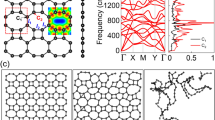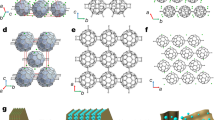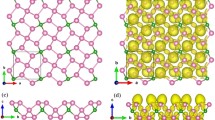Abstract
A new 2D material of biphenylene sp2-bybridized carbon sheet, a nonbenzenoid carbon allotrope, has been discovered. Using first-principles calculations, we report electronic properties of the 2D biphenylene carbon sheet (BCS) with hydrogenation using first-principles calculations. We found that hydrogen atoms adsorb on carbon atoms in square, hexagon, and octagon, to form sp3 hybridized bonds. Carbon atoms are in energy preferred to be adsorbed on carbon atoms in square while carbon atoms, which is in a contrast to graphene that have all identical sites. We also found that the band gaps of BCS can vary by from 0 to 4.24 eV as the concentration of hydrogens increases. Unlike graphene where hydrogen atoms show a tendency to cluster, hydrogen atoms are energetically dispersed in BCS, making band gap tuning feasible. These electronic properties in BCS indicate that the band gap of BCS by employing hydrogenation can be engineered for new device applications.







Similar content being viewed by others
References
Q. Fan, L. Yan, M.R. Trip, O. Krejci, S. Dimosthenous, S.R. Kachel, M. Chen, A. Foster, P. Liljeroth, J.M. Gottfried, Biphenylene network: a nonbenzenoid carbon allotrope. Science 372, 852–856 (2021)
R. Balog, B. Jørgensen, L. Nilsson, M. Andersen, E. Rienks, M. Bianchi, M. Fanetti, E. Lægsgaard, A. Baraldi, S. Lizzit, Z. Sljivancanin, F. Besenbacher, B. Hammer, T.G. Pedersen, P. Hofmann, L. Hornekær, Bandgap opening in graphene induced by patterned hydrogen adsorption. Nat. Mater. 9, 315–319 (2010)
Y. Lin, F. Ding, B.I. Yakobson, Hydrogen storage by spillover on graphene as a phase nucleation process. Phys. Rev. B 78, 041402 (2008)
H. Gao, L. Wang, J. Zhao, F. Ding, J. Lu, Band gap tuning of hydrogenated graphene: H coverage and configuration dependence. J. Phys. Chem. C 115, 3236–3242 (2011)
H. Xiang, E. Kan, S.-H. Wei, M.-H. Whangbo, J. Yang, “Narrow” graphene nanoribbons made easier by partial hydrogenation. Nano Lett. 9, 4025–4030 (2009)
S.S. Han, H. Jung, D.H. Jung, S.-H. Choi, N. Park, Hydrogen storage in metal-organic frameworks by bridged hydrogen spillover. Phys. Rev. B 85, 155408 (2012)
Y. Li, R.T. Yang, Hydrogen storage in metal-organic frameworks by bridged hydrogen spillover. J. Am. Chem. Soc. 128, 8136–8137 (2006)
R.H. Baughman, H. Eckhardt, M. Kertesz, Structure-property predictions for new planar forms of carbon: layered phases containing sp2 and sp atoms. J. Chem. Phys. 87, 6687–6699 (1987)
D. Malko, C. Neiss, F. Vines, A. Gorling, Competition for graphene: graphynes with direction-dependent dirac cones. Phys. Rev. Lett. 108, 086804 (2012)
V.R. Coluci, S.F. Braga, D.S. Galvao, R.H. Baughman, New families of carbon nanotubes based on graphyne motifs. Nanotechnology 15, S142–S149 (2004)
N. Narita, S. Nagai, S. Suzuki, K. Nakao, Optimized geometries and electronic structures of graphyne and its family. Phys. Rev. B 58, 11009 (1998)
B.G. Kim, H.J. Choi, Graphyne: hexagonal network of carbon with versatile Dirac cones. Phys. Rev. B 86, 115435 (2012)
J. Kang, J. Li, F. Wu, S.-S. Li, J.-B. Xia, Elastic, electronic, and optical properties of two-dimensional graphyne sheet. J. Phys. Chem. C 115, 20466–20470 (2011)
C.-H. Park, L. Yang, Y.-W. Son, M.L. Cohen, S.G. Louie, Anisotropic behaviours of massless Dirac fermions in graphene under periodic potentials. Nat. Phys. 4, 213–217 (2008)
C.-H. Park, Y.-W. Son, L. Yang, M.L. Cohen, S.G. Louie, Electron beam supercollimation in graphene superlattices. Nano Lett. 9, 2920–2924 (2008)
J.M. Kehoe, J.H. Kiley, J.J. English, C.A. Johnson, R.C. Petersen, M.M. Haley, Carbon networks based on dehydrobenzoannulenes. 3. Synthesis of graphyne substructures. Org. Lett. 2, 969–972 (2000)
T. Yoshimura, A. Inaba, M. Sonoda, K. Tahara, Y. Tobe, R.V. Williams, Synthesis and properties of trefoil-shaped Tris(hexadehydrotribenzo[12]annulene) and Tris(tetradehydrotribenzo[12]annulene). Org. Lett. 8, 2933–2936 (2006)
A.C. Johnson, Y. Lu, M.M. Haley, Carbon networks based on benzocyclynes. 6. Synthesis of graphyne substructures via directed alkyne metathesis. Org. Lett. 9, 3725–3728 (2007)
G.X. Li, Y.L. Li, H.B. Liu, Y.B. Guo, Y.J. Li, D.B. Zhu, Architecture of graphdiyne nanoscale films. Chem. Commun. 46, 3256–3258 (2010)
M.M. Haley, S.C. Brand, J.J. Park, Carbon networks based on dehydrobenzoannulenes: synthesis of graphdiyne substructures. Angew. Chem. Int. Ed. 36, 835–838 (1997)
W. Kohn, L.J. Sham, Self-consistent equations including exchange and correlation effects. Phys. Rev. 140, A1133–A1138 (1965)
G. Kresse, D. Joubert, From ultrasoft pseudopotentials to the projector augmented-wave method. Phys. Rev. B 59, 1758–1775 (1999)
J.P. Perdew, K. Burke, M. Ernzerhof, Generalized gradient approximation made simple. Phys. Rev. Lett. 77, 3865–3868 (1996)
H.J. Monkhorst, J.D. Pack, Special points for brillonin-zone integrations. Phys. Rev. B 13, 5188–5192 (1976)
A. Bafekry, M. Faraji, M.M. Fadlallah, H.R. Jappor, S. Karbasizadeh, M. Gherherehchi, D. Gogova, Biphenylene monolayer as a two-dimensional nonbenzenoid carbon allotrope: a first-principle study. arXiv::2105.14958.
Acknowledgements
This work was supported by the National Research Foundation of Korea (NRF) Grant (No. 2021R1A5A103299611) funded by the Ministry of Science, ICT and Future Planning (MSIP) of the Korean government.
Author information
Authors and Affiliations
Corresponding author
Additional information
Publisher's Note
Springer Nature remains neutral with regard to jurisdictional claims in published maps and institutional affiliations.
Rights and permissions
About this article
Cite this article
Lee, S., Singh, A. & Lee, H. Band gap engineering of 2D biphenylene carbon sheets with hydrogenation. J. Korean Phys. Soc. 79, 846–850 (2021). https://doi.org/10.1007/s40042-021-00312-x
Received:
Accepted:
Published:
Issue Date:
DOI: https://doi.org/10.1007/s40042-021-00312-x




